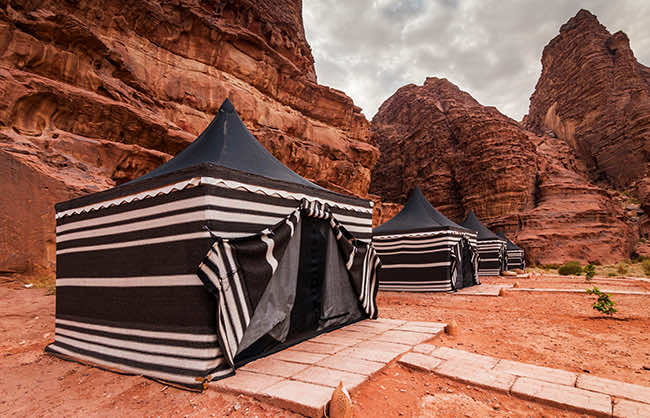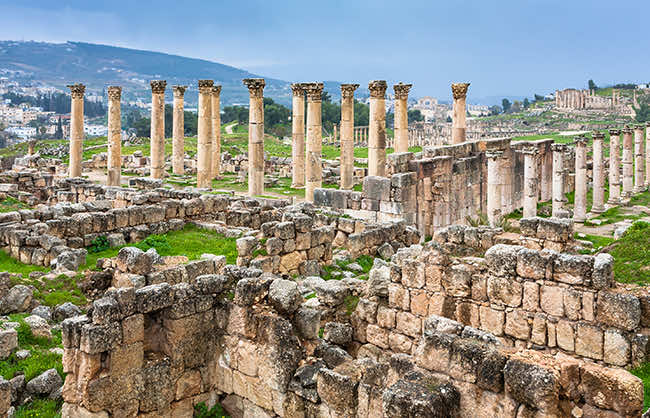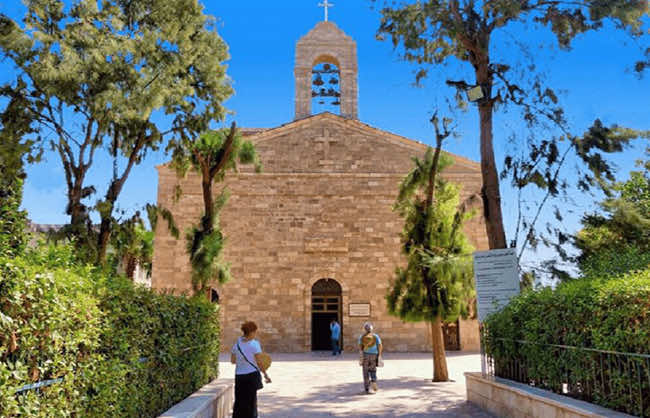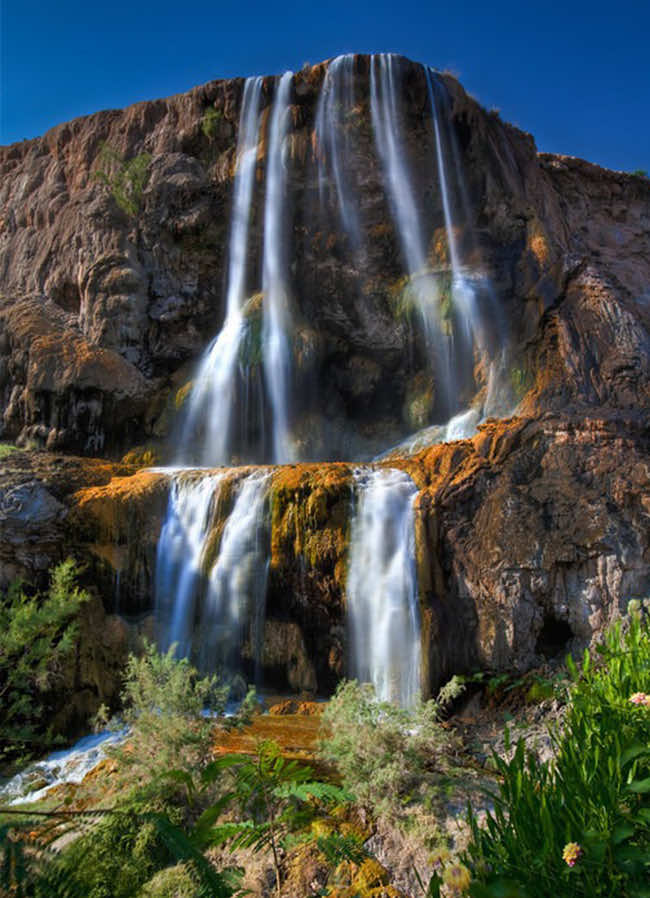
The kingdom of Jordan is one of the countries where you can inhale the smell of time, feel the magic of the East, see one of the world’s most charming wonders Petra, and many more.
Winter is a great season to visit Jordan because it’s a low season (if we exclude Christmas) resulting from the cold weather, but you can enjoy visiting the points of attraction calmly, and you’ll find reservations in most hotels and restaurants, especially now valentine day is coming on the way it will be a perfect getaway for lovers and unforgettable experience to share
Here is a list of places that you can visit in Jordan that will keep you warm and happy in the winter and all seasons:
1. Petra

Classified as one of the Seven Wonders of the World, Petra is an ancient city in present-day Jordan and dates back to the fourth century B.C. The ruins of the once-great metropolis and trading center now serve as an important archeologic site and tourist attraction.
The site is considered significant by historians and archeologists alike because of its beautiful rock-cut architecture and innovative water management system, which made the region inhabitable, given that it is surrounded by desert and rugged, mountainous terrain.
You can visit it by day and take a full tour of the whole site, or you can go “Petra by night” It’s a limited small event you’ll sit in front of the “Khaznah” enjoying candle lights listening to AL Rababa playing by a local man and listening to some cultural Jordanian stories drinking a local cup of tea, you’ll feel the presence of the lost ancients souls of the Nabateans.
The weather will be mildly cold during the day and extremely cold by night, so make sure you have heavy clothes and a heavy jacket for the cold nights.
2. Aqaba
Situated on the southern tip of Jordan, approximately 4 hours from the capital of Amman, Aqaba is a beach town with Jordanian appeal. Equipped with the local watering holes for water sports.
Unlike the rest of the kingdom’s regions, Aqaba is considered a hot area in the winter so you can enjoy a sunny day on the beach even in December. However, the weather is cold by night, it gets colder in January, but the weather starts to settle again in March.
Even though still there are a lot of things to do in Aqaba such as Swimming, Diving, water sports, and shopping in the local markets, If you’re visiting Aqaba in autumn or spring, it would be in your best interest to see the Aqaba Bird Observatory. With a mission to preserve the natural habitats of Jordan’s migratory birds, you can get an exclusive peek at the aquatic birds on their migratory routes between Africa, Europe, and West Asia. The Aqaba Bird Observatory is an excellent place for the whole family.
You can also take a journey of discovery through Aqaba’s Aquarium to reveal the hidden treasures of the Red Sea. As part of the Marine Science Station Complex, the Aquarium offers a chance to dive without getting wet and watch the aquatic life inside the Red Sea.
If you are a fan of diving, you have to visit the first underwater military museum just off the shores of Aqaba. A total of 19 pieces of hardware are all in “battle formation” and include tanks of different sizes, an ambulance, a military crane, a troop carrier, anti-aircraft guns, and a combat helicopter.
You can also visit The Cedar Pride was scuttled for divers on November 16, 1985. The ship now lies on her port side across two reefs; the soft coral growth on the masts is fantastic. Those with experience can explore its interior.
And, of course, the Japanese garden dive site has impressive flora and fauna and is all at shallow depths; it’s very popular with snorkelers and is known as one of the prettiest areas in Aqaba. It is a good dive for all, as it has Hawksbill Turtles, shoaling Barracuda, shoals of sergeant majors, and fusiliers, plus incredible coral formations.
After a significant ceremony organized by ASEZA and attended by international media and visitors, the “C-130 dive site,” the Marine Park’s latest attraction, was scuttled on November 16, 2017, and has already become the divers’ favorite.
Contact a local licensed dive center to book this experience.
If you are a golf fan, you must visit Ayla Golf Course and Academy; it is Jordan’s first 18-hole par-72 golf course, ranked among the world’s top three eco-friendly golf courses, the Ayla Golf Course boasts an extraordinary setting of the majestic mountains of Aqaba bay, it was designed by design philosophy to create a premier signature golf course that blends with their surrounding environment and enhances the properties’ natural features.
The facilities are running entirely on solar power, and the gold course accommodates golfers to practice long after sunset while enjoying the cool Aqaba evening breeze with friends.
If you’re a fan of water sports, you can visit Ayla Wake Park; it has a 442m cable wake park skiing facility; the thrill is granted through well-designed obstacles, ramps and sliders, and wide-open spaces for acrobatic water tricks.
You can also visit The Royal Aero Sports Club. The club aims to promote aero sports in Jordan and enhance the experience of tourists visiting Aqaba, the Dead Sea, and Wadi Rum.
3. Wadi Rum

The soft red sands, the enchanting mountains shaped like layers of rocks from another planet, the Fresh air smell, The beauty of the sky at night, and the moonlight surrounded by shiny stars. This is the charming atmosphere that you will experience in Wadi Rum.
Virtually all the people living in and around Wadi Rum today are of Bedouin origin and, until recently, led nomadic lives, relying on their goat herds. They are resourceful, hospitable people who are mainly responsible for developing Wadi Rum as a tourist destination, so what are the things that you can do there?
Wadi Rum is attracting more and more adventure seekers. It offers some of the most delicate rock climbing globally and is a spectacular place for desert trekking and safaris (camels, horses, and vehicles). Guide services, campsites, and logistical support are available locally, through independent operators.
4. The Dead Sea

The Dead Sea is the oldest natural spa on earth and one of the most fascinating places in the world.
It is a hypersaline salt lake on the southern part of the border between Jordan and Palestine-Israel, at the edge of the Judean Desert. It attracts tens of thousands of annual tourists, mainly due to the water’s unique buoyant qualities and mineral-rich mud. The area is one of the world’s oldest natural health resorts.
The Dead Sea is officially the lowest point on earth; the shore currently lies at 432.65 meters below sea level. It is surrounded by dozens of health retreats and luxury hotels, even in mid-winter tourists and visitors can relax on the beach and enjoy the sunshine. Still, from December to Feb, the weather is a bit cold these times, the sun will not appear during that season.
One of the unique experiences the Dead Sea offers is Floating in the water without making any effort resulting from the high level of salt in it. Just lay back, relax, and enjoy this natural phenomenon. Of course, you cant dive and don’t even think about soaking your head or face under the water, particularly your eyes, and it’s recommended to enter the water if you have any open cuts (remember NOT to shave or wax the same day).
5. Jerash

Jerash (aka Gerasa, Gerash, or Gerasha) is the capital and the largest City of the Jerash Governorate in Jordan. Still, in ancient times it was one of the wealthiest and most cosmopolitan cities in the ancient near east.
It was settled by humans as early as the Neolithic period (c. 7500-5500 BCE) and founded as a Hellenistic city in the 2nd century BCE. Jerash is today noted for its fine Roman and Byzantine ruins, which rank among the largest and best-preserved in the world. Jerash is located 48 km (30 miles) north of Amman – the capital of Jordan – and 40 km (25 miles) south of Irbid, Jordan.
Jerash is one of the most visited sites in Jordan after the Nabataean city of Petra. The city’s weather is relatively temperate compared to nearby Amman, The prolific rolling hills and valleys around Jerash have sustained human settlement and inhabitation for at least 6500 years, and the landscape around the ruined city is surrounded by olive trees, plum trees, fig-trees, wheat, eucalyptus, various shrub trees, and cedar trees.
For history lovers, this city will be heaven on earth for its rich ancient past and history. Jerash is surrounded by a group of restaurants serving the most delicious local food.
6. Ajloun
Northern Jordan has two of the most important ecological and historical attractions in the Middle East: the sprawling pine forests of the Ajloun-Dibbine area and the towering Ayyubid castle at Ajloun, which helped to defeat the Crusaders eight centuries ago.
With Ajloun Forrest Reserve, Roa deer trail, Soup House trail, Ajloun houses trail, Orjan village trail, Rockrose trail, Birgish, Wadi al Rayan, Sami’s cliff, reason olive press trail it is considered one of most beautiful forests.
Also, there is the glorious Ajloun castle; it is a 12th Century fortress that was built under the rule of the sultan and military leader Saladin. It is set on top of Mount ‘Auf. It is only 20 minutes from the Ajloun Forest Reserve and provides visitors with astonishing views of the Jordan Valley and surrounding desert.
Over the years, the castle has undergone many rebuilds, and although much of the original features no longer exist, there are many chambers, carvings, and towers to keep visitors interested; visitors can learn more about the castle’s history in the museum located on-site, the museum contains a collection of mosaics and interesting medieval weaponry.
7. Madaba

Known as the “City of Mosaics,” Madaba is the cultural epicenter for Byzantine and Umayyad mosaics. Just a short distance from the capital, visitors are just a stone’s throw away from the holy monuments of religious iconography.
The city is best known for its artistic beauty, adorned with mosaics from the Byzantine Empire; Madaba is a colorful city steeped in history, it is home to quite a small population that has the ambiance of a large market town rather than a city; it’s considered the most welcoming Jordanian city. Along with its stunning Byzantine designs, Madaba is the perfect place for shopping and dining.
One of the most famous sites in Madaba is St George’s Church which is home to a giant mosaic map. Visitors flock to this Greek Orthodox Church to catch a glimpse of the map, rediscovered by builders in 1884. It was initially built into a Byzantine church and is the oldest map of Palestine on record, believed to have been created in 560 AD.
Also, there is the Church of the Virgin and the Hippolytus Hall, which both form part of Madaba’s Archaeological Park and Museum.
On a clear day, visitors can see the Dead Sea, Bethlehem, and even Jerusalem from the top of Mount Nebo, the base of the mountain can be reached within fifteen minutes by car from the city center, and it is also a pleasant journey for cyclists.
8. Ma’in Hot Springs

The Ma’in Hot Springs is a real gem of a place and one that many visitors to Jordan are unaware of; the site is located in Jordan’s Madaba Governorate, between the city of Madaba and the Dead Sea.
There are several small springs and pools in and around the site, but the most popular pool is one that is fed by a cascading waterfall which is over 20 meters in height. The water in some of the pools reaches a temperature of around 63 degrees Celsius. While temperatures vary from one pool to the next, the mineral content of the water is virtually the same in all of the pools.
Many of the people who visit the Ma’in Hot Springs do so for therapeutic reasons, including things like bone and joint problems, certain skin diseases; some circulatory illnesses, etc., but many locals and tourists also visit the site purely for the sake of relaxing, also the outstanding beauty of the place.
There are many hot springs around the world, but not many where you can stand directly beneath a naturally heated waterfall; for many people, visiting Ma’in Hot Springs is truly a once-in-a-lifetime experience.
9. Down Town – Al Balad – (Amman)
The Balad is the oldest section of the city. It is believed to have first been inhabited during the Neolithic period (around 6500 B.C.). The seven jabals (hills) around it was occupied during the same time and formed the perimeter of the young city.
Markets in the Balad smells of originality and heritage, were trafficked by locals of all stripes, and tourists throughout most of the 20th century, it became a popular market with years going by.
There is a concentration of the oldest central markets for vegetables, clothes, and secondhand clothes within the area. Also, many restaurants serve local food and a variety of Juice stores that serve natural refreshing juice.
We should not forget to mention that the area’s long history, having been built up over ancient ruins, leaves many historical sites, such as the nearby Amman Citadel with the Umayyad Palace, the Hashemite Plaza with the Roman Theatre, and the Odeon.
The Roman Nymphaeum, a New archaeological excavation, was ongoing in 2020. Scholars reason that part of the draw to this location in ancient times was likely the proximity to the now mostly-dry Amman River.
10. Umm Qais

Site of the famous miracle of the Gadarene swine, Gadara was in its time a cultural center; it was the home of several classical poets and philosophers, including Theodorus, founder of a rhetorical school in Rome, and was once called “a new Athens” by a poet, perched on a splendid hilltop overlooking the Jordan Valley and the Sea of Galilee.
Gadara is known today as Umm Qais with its impressive colonnaded street, a vaulted terrace, and the ruins of two theatres. You can take a tour and then dine on the balcony of a fine restaurant with a splendid view.
Of course, there is Umm Qais Museum, it is located in one of the houses in the Ottoman village of Umm Qais, there are two exhibition halls in it: In the first hall, various ceramics dating from the Hellenistic up to the Islamic periods are on display, along with finds from the tombs at Umm Qais, the second hall is for statuary, mainly from the Roman period. Into the large courtyard, basalt sarcophagi, column capitals and bases, two basalt gates, mosaics, and the famous seated Tyche were moved from the site.
About the archeological site, Umm Qais (Gadara), built using stunning black basalt stones, was one of the cities of the Decapolis, planned with a Roman city layout.
Visitors can view the Syrian Golan Heights, Mount Hermon, Lake Tiberias, and the north Palestinian plains.
Also, there is beekeeping at baraka destinations; the beekeeper will introduce you to the fascinating queendom of bees before permitting a sneak peek into the hives; the product is naturally sweet and additive-free honey, which changes in taste depending on the year.



